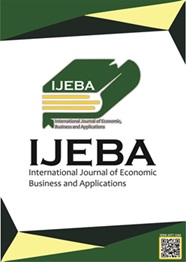The Effect of Internet Banking, Size, NPL and CAR on Net Interest Margin (NIM) and Banking Efficiency in Indonesia During Covid-19 Pandemic
Abstract
ABSTRACT: This study analyzes the effect of Internet Banking, Size, NPL and CAR on profitability and efficiency of Indonesian banking as proxied by Net Interest Margin (NIM) and Operating Costs and Operating Income (BOPO) during the pandemic COVID-19 (2020-2021). This study also looks at the effect of Firm Size (Size), Capital Adequacy Ratio (CAR) and Non Performing Loans (NPL) on profitability and efficiency in that period. The population is Indonesian conventional banks registered in Bank Indonesia (2020-2021), totaling 117 banks. The sample was determined using purposive sampling, 62 banks in total. The method used is multiple linear regression with dummy variables. The results showed that internet banking had a significant negative effect on NIM and internet banking had a significant positive effect on BOPO. Another variable is size has no effect on NIM and has a significant negative effect on BOPO. CAR has no effect on NIM and has a significant negative effect on BOPO. Meanwhile, NPL has a significant negative effect on NIM and a significant positive effect on BOPO. The factor that has the biggest influence on NIM is NPL. While the factors that affect BOPO more are CAR and NPL. Banks are expected to pay more attention to the level of capital adequacy, credit risk and the level of total assets to increase bank profitability and efficiency in the future in dealing with the pandemic situation.
Keywords
Full Text:
PDFReferences
Abdullah. (2020, June 20th). Ada Corona, Kenaikan Biaya Operasional Bank Diprediksi Terus Berlanjut. Bisnis.com. Retrieved from https://finansial.bisnis.com/
Ananda, Chandra. (2021). Resiliensi Perbankan. Fakultas Ekonomi dan Bisnis Universitas Brawijaya. Retrieved from https://feb.ub.ac.id/
Angelakopoulos. (2011). “E-banking: challenges and opportunities in the Greek banking sector”. Electronic Commerce Research, 11(3), 297-319. https://doi.org/10.1007/s10660-011-9076-2
Brigham, E. (2010). Dasar-Dasar Manajemen Keuangan Edisi 11. Jakarta: Salemba Empat
Dendawijaya, L. (2009). Manajemen Perbankan. Jakarta: Ghalia Indonesia.
Djalante, R. (2020). “Review and analysis of current responses to COVID-19 in Indonesia: Period of January to March 2020”. Progress in Disaster Science. https://doi.org/10.1016/j.pdisas.2020.100091
Elmawati. (2014). “Pengaruh Reputasi Kantor Akuntan Publik (KAP), Audit Tenure, dan Disclosure terhadap Penerimaan Opini Audit Going Concern”. Diponegoro Journal of Accounting. Vol 3, No 2, 2014
Fungacova, Zuzana., & Poghosyan, Tigran. (2011). “Determinant of Bank Interest Margin in Russia : Does Bank Ownership Matter?”. Journal of Economics Systems 35, 481-495.
Ghozali, I. (2016). Partial Least Squares: Konsep, Teknik dan Aplikasi Menggunakan Program SmartPLS 3.0. Semarang: Badan Penerbit Universitas Diponegoro.
Gujarati, D.N. (2006). Dasar – Dasar Ekonometrika. Jakarta: Erlangga.
Hery. (2017). Kajian Riset Akuntansi: Mengulas Berbagai Hasil Penelitian Terkini dalam Bidang Akuntansi dan Keuangan. Jakarta: PT. Gramedia.
Jiménez-Hernández. (2019). "Determinants of bank efficiency: evidence from the Latin American banking industry", Applied Economic Analysis, Vol. 27 No. 81, pp. 184-206. https://doi.org/10.1108/AEA-09-2019-0027
Kasmir. (2014). Bank dan Lembaga Keuangan Lainnya Edisi Revisi 2014. Penerbit PT. Raja Grafindo Persada: Jakarta.
Kiryanto, Ryan. (2021, September 7th). NIM Industri Perbankan Terus Menurun Akibat Covid-19. Ipotnews. Retrieved from https://www.indopremier.com/
Maheswari, Kadek I., and I. M. S. N. Sudirman. "Pengaruh NPL terhadap ROA dengan Mediasi CAR dan BOPO pada Perbankan Indonesia." E-Jurnal Manajemen Universitas Udayana, vol. 3, no. 4, 2014.
Margaretha, F. (2015). “Dampak Electronic Banking terhadap Kinerja Perbankan Indonesia”. Jurnal Keuangan dan Perbankan (Vol. 514, Issue 3). http://jurkubank.wordpress.com
Muhammad Arif. (2020). “Pengaruh Internet Banking Terhadap Kinerja Perbankan”. E-Journal EcoGen UNP: Vol. 3 No. 4 Online ISSN 2654-8429. http://ejournal.unp.ac.id/students/index.php/pek/index
Otoritas Jasa Keuangan (OJK), https://www.ojk.go.id/, Accessed in August, 2021.
Perwitaningtyas, G. (2015). Faktor-Faktor yang Mempengaruhi Efisiensi Bank di Indonesia Periode Tahun 2008-2012. Diponegoro Journal of Management, 0, 28-41.
Plakalovic, Novo & Alihodzic, Almir. (2015). “Determinants of the Net Interest Margins In BH Banks”. Industrija. 43. 133-153. https://doi.org/10.5937/industrija43-7544.
Roxana. (2021). “The Impact of The COVID-19 Pandemic on The Banking Sector”. Management Dynamics in the Knowledge Economy vol. 9, issue 2, 203-224 https://doi.org/10.2478/mdke-2021-0013
Siamat, Dahlan. (2005). Manajemen Lembaga Keuangan. Publisher: Fakultas Ekonomi Universitas Indonesia.
Sugiyono. (2015). Metode Penelitian Bisnis (Pendekatan Kuantitatif, Kualitatif, dan R&D). Alfabeta: Bandung.
Syafri, Riza. (2021, Desember). Transformasi Digital Perbankan dan Dampaknya Terhadap Perekonomian. Bulletin APBN Vol. VI. Ed. 23
Weill, P. (2015). “Thriving in an Increasingly Digital Ecosystem”. MI Sloan Management Review. 56. 27-34.
Yang, S., Li, Z., Ma, Y., & Chen, X. (2018). “Does Electronic Banking Really Improve Bank Performance? Evidence in China”. International Journal of Economics and Finance, 10(2), 82. https://doi.org/10.5539/ijef.v10n2p82
DOI: http://dx.doi.org/10.31258/ijeba.8.1.69-90
Refbacks
- There are currently no refbacks.





.png)
.png)
.png)


